As a flooring contractor, you’ve got a great way to earn money from your clients through your superb servicing. However, do you have a similarly easy way to bill them? Are you having trouble finding a solid and consistent template that can help you round out all of the flooring services you rendered? If so, then you need to know how to create a flooring contractor invoice. It’s a quick and easy way to bill your customers and get paid fast.
Table of Contents
ToggleWhat is a Flooring Contractor Invoice?
A flooring contractor invoice is a type of invoice document made for companies that perform flooring installation services. It details all the flooring-related services and materials that the company has provided to its customers.
A flooring contractor invoice serves the purpose of getting businesses paid for their goods and services. Like other invoices, it serves as an official notice that a flooring company is asking for payment. Once your client receives this document, they will then transfer money into the business’s account.
What is a Flooring Contractor?
A flooring contractor is either a single professional or an entire company that provides flooring services. An excellent flooring company has a solid reputation, rich history or experience, and one that follows industry standards.
Flooring contractors should only be acquired for the job if they offer insurance and a warranty in case of accidents or unexpected events. There are four common types of flooring jobs that professional contractors perform:
- Commercial
- Hardwood
- Epoxy
- Concrete
A flooring contractor is mainly responsible for measuring and cutting the materials (wood or carpeting) that match a floor’s quality and dimension. Flooring contractors are in demand because many people think that flooring jobs require professional hands.
A flooring contractor can perform a floor job that involves hazardous work. If the installer is unprepared or educated on the floor job, customers can end up with mediocre results. That’s why customers need to choose the right contractor for the job. As a flooring contractor, this high demand is something that you should take full advantage of.
For example, when installing a hardwood floor, proper sanding is an essential task. At the same time, it’s also performed regularly, which produces dust-like substances to fly through the air. If the person conducting the sanding process isn’t aware about wearing proper protective gear, extreme consequences will occur. They could suffocate or suffer damages to their lungs.
Either way, it can delay the entire work. That’s why it’s essential to have an absolute professional do the job in the first place.
Flooring Contractors Earnings
Anyone who has the talent and passion for executing floor work can become a flooring contractor. No degree is required since you’ll eventually grasp the nature of the work through experience.
After a few years in the industry, you can now start your own flooring company and maximize your earnings. In the recent survey conducted by the US Bureau of Labor Statistics, a typical flooring contractor earns roughly $40,000 – $50,000 per year. They also gave details to other types of flooring contractors and their corresponding salaries. These additional stats are listed below:
- Floor sanding and polishing contractors – Salary: $39,800, Hourly wage: $19.20.
- Floor laying contractors – Salary: $46,700, Hourly wage: $22.50.
- Carpet installation contractors – Salary: $44,500, Hourly wage: $21.40.
- Tile and marble setting contractors – Salary: $45,900, Hourly wage: $22.10
How to Create a Flooring Contractor Invoice?
You can create a flooring contractor invoice in the same manner as any other typical invoice. However, the header should state, “flooring contractor invoice,” to make sure the recipient knows what document they’re receiving.
There are tons of invoicing platforms available online. Some will let you create invoices straight from their platform. Others will let you download one of their professional invoice templates to make invoice creation a breeze.
However, if you choose to create your invoice manually, you can follow the steps below:
- Open a word processing application like Microsoft Word or Google Docs.
- Start adding your name, business name, and contact information.
- Include brandings like your logo and your company’s color scheme.
- Insert your customer’s name and contact information. Add their business name if necessary.
- Make sure you incorporate a unique invoice number to go along with the invoice date and corresponding due date.
- List the flooring services that you’ve provided, along with other items that you intend to charge your client as part of the project.
- Incorporate a short but concise description for each line; add the corresponding price for each item.
- Calculate the total amount and include it at the bottom of your list.
- Add your invoice policy along with any discounts or promos that you may have at the very bottom of the document.
Of course, if you choose to download a free template, you won’t have to go through the hardships of starting from scratch. All you need is to download the free floor contractor invoice template available on invoicing platforms like FreshBooks or create a free account with ReliaBills and start making flooring invoices for free. Fill out the blank form fields available on the invoice template, and you’re all done!
What Should be Included in your Flooring Invoice?
Invoicing requires accurate details of the flooring services you provided to your customer. It’s important to note that you’ll be fitting a lot of information into your flooring contractor invoice. At the same time, you need to make it as orderly and organized as possible. In terms of what you’ll include, make sure your invoice reflects the following information:
- Your company name.
- Your contact information
- Any license information for the contractor licenses that you hold.
- A brief yet concise description of the work you’ve done or the job you’re about to do.
- The materials you’ll be using.
- Labor time spend on the flooring project.
- Include payment methods that you accept (bank transfer, credit card, PayPal, etc.)
- The total cost of the entire work.
All of these details should be in a format that will be easy for you to reference. At the same time, it should also be easy for the customers to read and understand. If your client requests a physical invoice, you can print the one you’ve created. That means you’ll have two options to provide your invoice.
Improve Your Payment Processing With Recurring Billing
Creating the perfect floor contractor invoice is excellent. But if you want to make it better, you need to add automation into your entire payment processing. Automating your invoices will benefit your business and make it very convenient for you and your customers.
When you choose recurring billing for your business, you can improve payment processing in many ways:
- Reduce the risk of chargebacks, returns, and customer disputes. When you remove human error from your invoicing process (by setting up automated monthly payments), customers are less likely to contest charges or request refunds.
- Lower your administrative costs and improve cash flow management. With automated invoicing, you can avoid late fees from missed billing cycles as well as the laborious process of managing paper budgets and manually chasing down overdue payments.
- Increase customer satisfaction and retention. Recurring billing introduces a whole new level of convenience. It helps reduce disputes, delays, and paperwork for customers to manage. Automated billing also gives you a chance to communicate with your customers about changes in terms of their subscriptions, upcoming renewal dates, and other important information that they need to know.
- Increase Your Business’s Bottom Line. Recurring payments are popular among businesses that offer subscription-based services because they provide steady cash flow and reduce additional costs. It also helps boost your company’s bottom line by reducing late fees and other associated costs of missed payments. Because recurring billing is automated, you no longer have to spend time chasing down overdue invoices or worrying about customers requesting refunds for charges made on their behalf.
Customers LOVE Recurring Billing
Customers appreciate receiving automated invoices because it means they no longer have to worry about missing payments or being late on their bills. It also means that you can communicate with them quickly and keep them updated on the changes in your products, services, fees, shipping costs—anything related to their subscription plan.
In addition, since recurring billing is automated, customers are less likely to contest charges or request refunds. It is also a great way to retain customers who might otherwise consider switching providers due to billing errors or missed payments.
It’s the Ultimate Resource Saver
Your business can also save time and money with automated recurring billing instead of the traditional way of collecting customers’ credit card information on file, manually sending invoices, and chasing down late payments. The automated billing process also saves you money because fewer administrative costs are associated with missed or delayed payments, disputed charges, returns, refunds, etc.
Those who choose to use recurring billing can avoid the laborious task of managing paper budgets by setting up automatic monthly bills for their customers; they don’t have to spend time manually chasing down overdue invoices, and they can save the cost of late fees.
Businesses that offer recurring billing also benefit by not dealing with customer disputes, returns, and other issues associated with missed payments or billing errors. Recurring billing is an excellent way for businesses that rely on subscription-based models to increase their cash flow and streamline administrative processes. It also provides customers with a hassle-free way of paying for recurring services while increasing customer satisfaction in the process.
Try ReliaBills Today!
If you want to take advantage of automated recurring billing, you must choose the ideal platform to offer you all the features you need to achieve an automatic payment process. With ReliaBills, you can streamline your recurring billing process with automated invoicing, payment processing, and detailed reporting.
ReliaBills is a professional-level invoicing and recurring billing platform; we offer the features and tools you need to get started with your transition towards recurring billing. All of your billing data is securely stored in one place, so it’s easily accessible at any time.
You can also make changes to an invoice template anytime and see them reflected on all future invoices without recreating or resending anything; this saves you even more work!
The ReliaBills recurring billing is an automated process, so you’ll never have to worry about manually processing late payments or dealing with complicated payment terms. In addition, ReliaBills offers real-time reporting so that you can keep track of how your business is doing profit-wise at any given period. With this level of control and insight into your recurring billing processes, you’ll be able to run your business more efficiently. If you’re interested in what ReliaBills has to offer, you can create a free account now to get started. Keep in mind that recurring billing is only available on ReliaBills PLUS.
How to Create a New Recurring Invoice Using ReliaBills
Creating a New Recurring Invoice using ReliaBills involves the following steps:
Step 1: Login to ReliaBills
- Access your ReliaBills Account using your login credentials. If you don’t have an account, sign up here.

Step 2: Click on Recurring Invoices
- Navigate to the Invoices Dropdown and click on Recurring Invoices for an overview of the list of your existing customers.

Step 3: Go to the Customers Tab
- If you have already created a customer, search for them in the Customers tab and make sure their status is “Active”.

Step 4: Click the Create New Recurring Invoice
- If you haven’t created any customers yet, click the Create New Recurring Invoice to create a new customer.
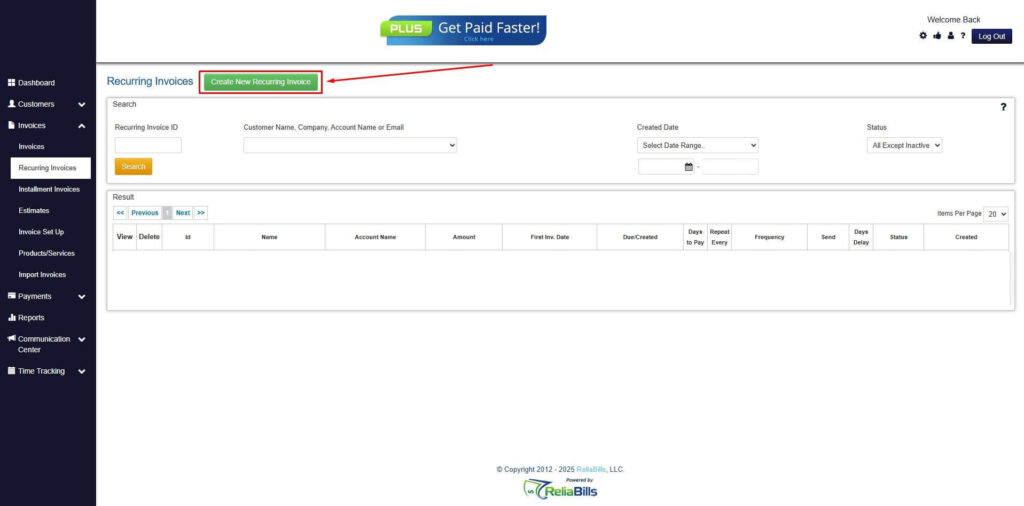
Step 5: Click on the “Click here” Button
- Click on the “Click here” button to proceed with the recurring invoice creation.

Step 6: Create Customer
- Provide your First Name, Last Name, and Email to proceed.
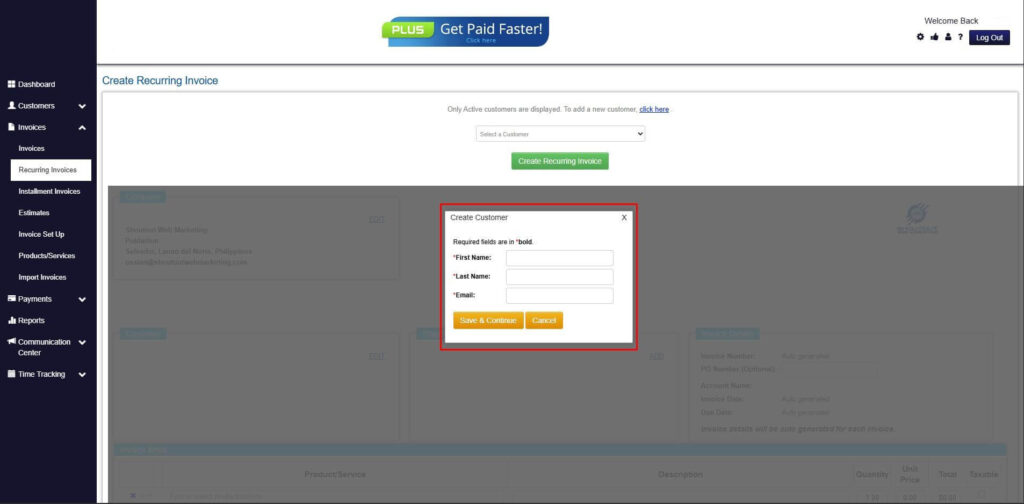
Step 7: Fill in the Create Recurring Invoice Form
- Fill in all the necessary fields.
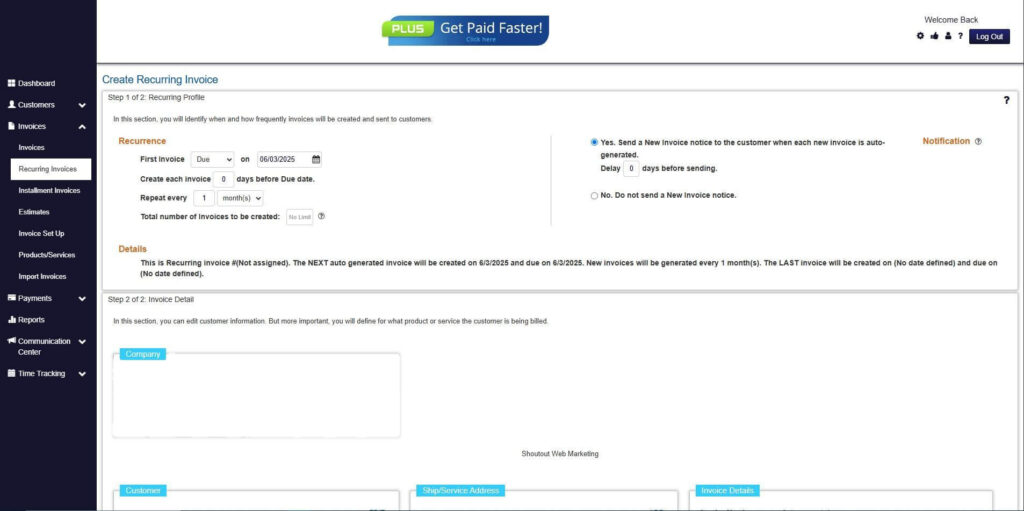
Step 8: Save Recurring Invoice
- After filling up the form, click “Save Recurring Invoice” to continue.
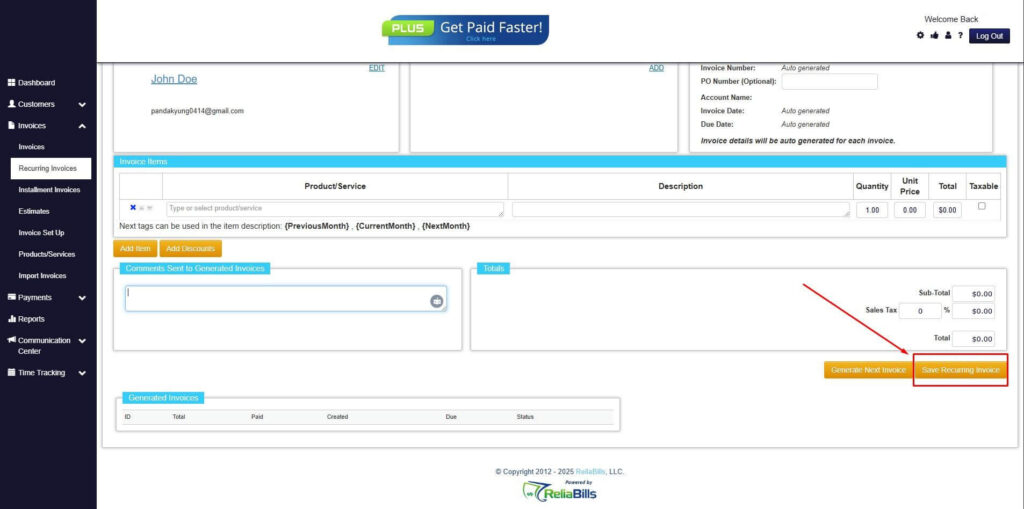
Step 9: Recurring Invoice Created
- Your Recurring Invoice has been created.
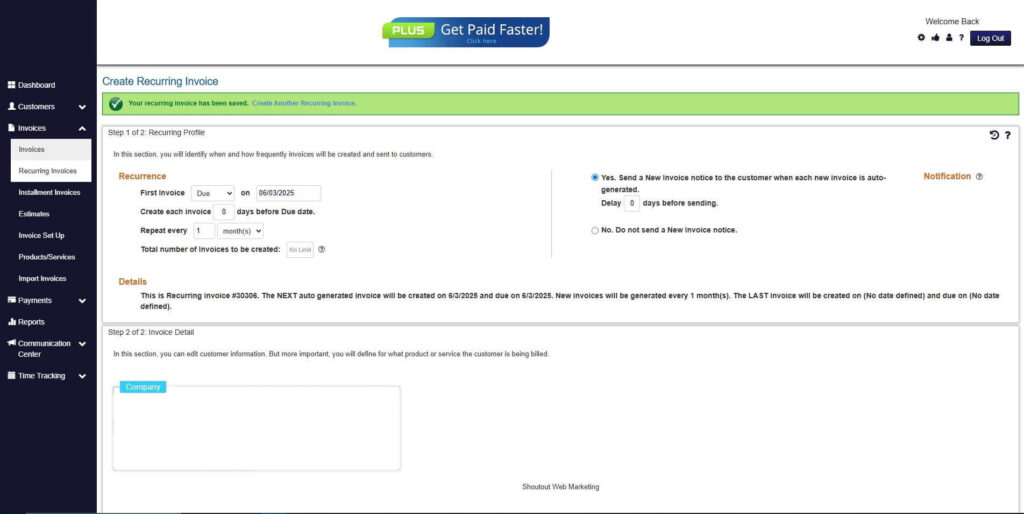
Wrapping Up
Creating a flooring contractor invoice is not that hard. As long as you know the proper steps on creating one, you’ll be able to do so without much hardship. If you want to make it easier, try ReliaBills. This invoicing platform lets you create and send your invoices in one convenient platform.
All you have to do is edit your invoice and add all the relevant information, and you are all set. You can then send your invoice to your customers and track its progress via email notifications.

